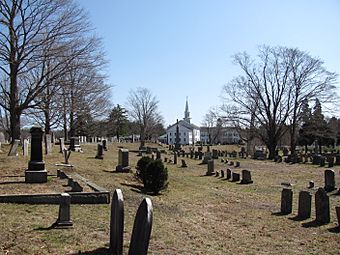Hanover Center Historic District facts for kids
Quick facts for kids |
|
|
Hanover Center Historic District
|
|

Hanover Center Cemetery
|
|
| Location | Hanover, Massachusetts |
|---|---|
| Area | 42 acres (17 ha) |
| Built | 1727 |
| Architect | Beal, J. Williams; Beal, John Woodbridge, et al. |
| Architectural style | Greek Revival, Georgian, Colonial |
| NRHP reference No. | 96000476 |
| Added to NRHP | May 9, 1996 |
The Hanover Center Historic District is a special area in Hanover, Massachusetts. It's like a time capsule showing how the town center looked long ago. This district includes important buildings like the town hall, library, and church. It also has the town's first cemetery and the old Stetson House. The Stetson House was built around 1700, making it one of Hanover's oldest buildings. This historic area was added to the National Register of Historic Places in 1996.
Exploring Hanover's Historic Center
The area we now call Hanover was first settled around the year 1700. Back then, it was part of a larger town called Scituate. Much of this land was given to a person named Cornet Robert Stetson in 1634. His son, Benjamin Stetson, likely built the old house that still stands today.
Early Days and Town Beginnings
The Stetson House, built around 1700, was made bigger in 1716. Important meetings were held here that led to Hanover becoming its own town in 1727. In that same year, the town's first cemetery was created. The first meeting house, a place for town gatherings and worship, was also built then. Today, the First Congregational Church stands where that first meeting house once was.
Buildings of the Town Center
Over the years, Hanover's center grew to include many important buildings. These buildings helped the town function and serve its people. The historic district covers seven properties. They are located around where Hanover Street (Massachusetts Route 139) meets Main and Silver Streets. This spot is near the very middle of town.
- The Stetson House: This old house is on the south side of Hanover Street. It is now a museum run by the local historical society.
- Curtis Free Library: Built in 1907, this library has a style called Federal Revival. It's a beautiful place for books and learning.
- Town Hall: The town hall was built in 1863. It has an Italianate style, which means it looks like buildings from Italy. This is where the town's government works.
- First Congregational Church: This church, built in 1863, is in a central spot. It's on a small "island" surrounded by the three main roads.
- Town Cemetery: The cemetery is located just north of the church. It's a quiet place where many of Hanover's early residents are buried.
- Sylvester School: East of the church is the Sylvester School. It was built in 1927 in the Colonial Revival style. This was Hanover's first public high school.
- Parsonage House: West of the church stands the parsonage house. This home, built around 1855, was where the church's minister lived.



